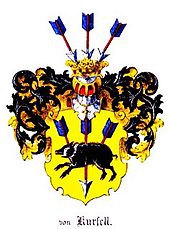Heading
Italic is the name of a German-Baltic noble family .
history
From 1442 the Kursell family, first with Georg (Jörg, Jürgen) von Kursell , appeared as vassals and feudal bearers of the Teutonic Order in Courland , from there to Livonia , Estonia and Ösel as well as Silesia . There is no evidence of where the family originally came from. Some genealogists consider an origin from France to be possible, but this assumption is based solely on the consonance with the French name Courcelle (s) .
The family seat was Sommerpahlen Castle in the Werro County in Estonia, which was destroyed in 1558 at the beginning of the Livonian War . The family later hired some high-ranking officers for Sweden , Russia , Prussia and Germany.
So was Alexander Otto Adolf Werner Kursell (1881-1905) Imperial Russian naval officer and sank with the flagship of the Baltic Fleet, the Prince Suvorov in 1905 in the Battle of Tsushima . Claus von Kursell (1910–1959) was an officer in the Wehrmacht , in October 1944 he was awarded the Knight's Cross of the Iron Cross , and later he joined the newly founded Bundeswehr as a major . During the National Socialist era, as a farmer, he investigated the usefulness of the safflower plant for the production of oil.
At the beginning of the 18th century, part of the family emigrated to the Kingdom of Prussia and settled in Silesia . This branch of the family was called Kurssel and died out in the early 20th century.
coat of arms
- Estonia: In gold, a running black boar, equipped with three fan-shaped fallen red arrows with blue flippers, the middle one with a silver tip reaching into the base of the shield; on the helmet with black and gold covers three fan-shaped arrows with blue flippers and silver tips.
- Silesia: In silver on green ground a striding black boar, armed with three fallen iron arrows with golden flippers; on the helmet with black and silver covers three blue roses with gold studs, each equipped with one of the arrows.
Known family members
- Klaus Kursell († June 3, 1570 executed), 1558 lord of the summer stalls , 1567 lord of Leal and Matzal Castle , 1567–1570 Swedish field chief, leader of the German courtiers in Estonia
- Johann Friedrich von Kursell (1678–1758), Swedish colonel, Estonian district administrator and Evangelical Lutheran consistorial president
- Christopher Engelbrecht von Kursell (1685–1756), Swedish captain and Estonian knighthood captain
- Heinrich Adolf von Kurssel (1693–1758), Prussian major general and chief of regiment No. 37, knight of the order Pour le Mérite , progenitor of the Silesian line
- Christopher Heinrich von Kursell (1722–1795), was Herr auf Ocht, a Prussian lieutenant and a Russian lieutenant general
- Moritz Engelbrecht von Kursell (1744–1799), Estonian knight governor, government aristocratic marshal , Russian real councilor, president of the court of conscience in Estonia, curator of the cathedral school in Reval
- Karl Heinrich von Kurssel (1780-1853), Prussian lieutenant general
- Karl Otto von Kursell (1788–1813), Russian officer, knight of the order Pour le Mérite
- Alexander von Kursell (1801–1857), Russian major general
- Konstantin von Kursell (1806–1880), Russian lieutenant general
- Friedrich (Fedja) Theodor von Kursell (1831–1891), Russian major general
- Otto von Kursell (1884–1967), German-Baltic painter and graphic artist , Ministerialrat and member of the Reichstag
- Claus von Kursell (1898–1990), representative of IG Farben in Estonia.
- Claus von Kursell (1910–1959), officer in the Wehrmacht and the Bundeswehr, bearer of the Knight's Cross of the Iron Cross, plant researcher
literature
- Genealogical manual of the nobility . Volume 97, Adelslexikon . Volume VII, 1989, pp. 98-99.
- Genealogical handbook of noble houses B 13. 1980, pp. 177-202.
- Genealogical manual of the Baltic knighthoods . Part 2, 1.2: Estonia, Görlitz, 1930, ( p. 115ff. )
- Yearbook of the German nobility . Third volume. Bruer, Berlin 1899, pp. 195-198
- Otto Magnus von Stackelberg : Moritz Engelbrecht von Kursell, Estonian knight captain. 1744-1799. Baltic Monthly Vol. 55, pp. 277ff.
- Ernst Seraphim : Colonel Klaus Kursell and his time. A picture of Estonia in the early days of Swedish rule. (= Library of Livonian History, Vol. 1.) Reval 1897.
- Baltic Historical Commission (Ed.): Entry on Kursell. In: BBLD - Baltic Biographical Lexicon digital
Web links
Individual evidence
- ↑ Igor Bunitsch: Knjas Suvorov. Istoricheskaya Chronicle. Saint Petersburg 2003 (Бунич Игорь: Князь Суворов. Историческая хроника. Санкт-Петербург 2003)
- ↑ Michael Garleff , Karl Ernst von Baer Foundation, Baltic Historical Commission (ed.): Baltic Germans, Weimar Republic and Third Reich. Volume 1 of The Baltic States Past and Present. Böhlau Verlag, Cologne Weimar 2007, ISBN 978-3-412-12299-7 , p. 331.
- ^ Claus von Kursell: Breeding work on the new oil plant safflower. Plant cultivation 15 (12) Leipzig 1939, p. 467; Ders .: Breeding and economic importance of safflower. in: The mill. Issue 41, Leipzig 1940.
- ^ Johann Gottfried Herder Institute : Journal for East Central Europe Research. Volume 45, JG Herder Institute, 1996, p. 603.
- ↑ Jürgen von Hehn : The resettlement of the Baltic Germans. The last chapter in Baltic German history. Thorbecke, 1982, ISBN 9783879691692 , p. 80.

